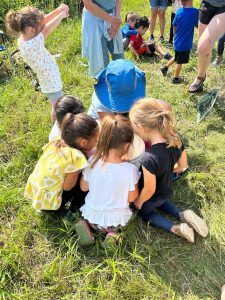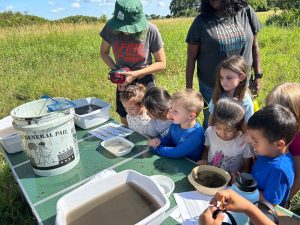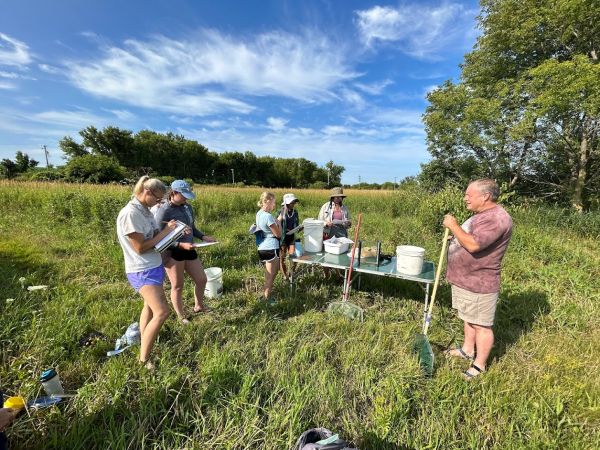
Finding Black Cohosh, Surveying a Stream and Destroying Turfgrass – CLIP Week 7
by Emma Klein and Leah Williams
Welcome to week seven of TLC’s 2023 Conservation Leader Internship Program! This week’s update is provided by Emma and Leah.
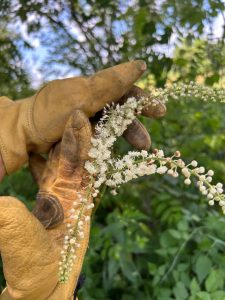
We kicked off the week with Plants of Concern (POC) monitoring at a top-secret location. This time, we were surveying the density and spread of black cohosh (Cimicifuga racemosa), an ‘at risk’ species often used for medicinal purposes. Similar to our POC monitoring of poke milkweed, this process involved individually counting the number of flowering and non-flowering individuals within a population, as well as noting any expansions in the population. While our monitor leader, Dennis, believes that black cohosh smells like vanilla, we all agreed that it smells more like rotting food. Also leading us was Susanne Masi, founder of the Plants of Concern program established in 2001. After all populations of cohosh had been thoroughly observed and reported, we headed to the Boger Bog! Here, TLC board president Ders Andserson educated us about the bog’s glacial history.

We followed up the next day with more surveying, this time for fish species at Harvard Gateway Park. Led by Nancy and Randy of the Environmental Defenders, this stream survey uses fish as indicators of environmental quality within a body of water. After suiting up with water shoes, fish nets and buckets, we waded through Rush Creek to collect our samples. These fish were then counted and identified, and the data was later used to calculate the IBI (index of biological integrity) of this particular stretch of water.
We were also visited by our good friends from the Brown Bear Daycare Center, who got a chance to observe different fish species up close, such as the Johnny darter, brook stickleback, and creek chub. Stream monitoring is an important part of ecological conservation because it allows us to better understand and protect our aquatic resources, especially concerning pollution. Today’s workshop allowed the CLIPsters to participate in this sphere of aquatic environmentalism, as well as to become more comfortable with survey protocol and native fish identification.
The next day we sprayed the teasel population at the Wonder Lake Sedge Meadow. Teasel is the most prevalent there of all the TLC sites, but hopefully not any more. I think all of us are experts at spotting the first year rosettes now. They always lie flat and spread out on the ground, looking a bit like overgrown wilted dandelion leaves, and often hard to see below surrounding plants. I’ve never seen another plant that does that yet, and wonder why. But I have noticed that it would potentially block other plants from sprouting where the leaves are, helping to reduce the competition. My own personal theory is that it’s trying to avoid detection by the CLIP interns with our backpack sprayers!
Thursday is always the day that we do workdays. This week it was at Gateway Park in Harvard, where we had done the stream survey two days earlier. But this time we hauled and burned brush, working to clear out the area. Katie, Jenn and Nari also pulled parsnip, and even found another patch and obliterated that too. We’ve been working against time to get as much done as possible before it finishes seeding, and recently we’ve been spending about 30 hours a week pulling it. Sometimes I wonder if I even pull parsnips in my dreams.
The rest of us hauled brush, and Emma practiced her chainsaw skills with Megan. We switch on and off on lessons during workdays so all of us learn. Using a chainsaw is an important conservation skill, but it can be hard to get training for it, so Megan has us practice during workdays.
Later in the morning, David had Larry, me and another volunteer help him clear a tangle of downed tree branches and debris out of Rush Creek. It looked almost like a tree had fallen near there years ago, with a log the size of a tree trunk submerged in the creek, and more piled on top. David used his chainsaw and the rest of us hauled brush out onto the banks. We just managed to get the stream cleared in reasonable time and haul the tree trunk out right before lunch. I’m curious to see how that section of creek will change now. The area where the logs were had built up a layer of silt, and the logs had nightshades and jewelweed growing out of them. Kim even spotted a monkey flower on one by the bridge! Needless to say, that log is now carefully placed beside the creek bank to keep the plant alive.
Later we collected seed at Irish Oaks. We got a pretty nice sedge mix, and learned a handful of new sedges. My favorite is tussock sedge, with its different colors and weird shape. I want to know how it got its name, since I’ve never seen another sedge like it. But if you use a little imagination, the seedhead looks somewhat similar to a tussock moth caterpillar on a stem. Tussock moths vary massively in appearance, but whitish and darker grays are two very common colors, and they’re always covered in hairs. Maybe that’s why, but I still want to know.
Then on Friday we worked at Apple Creek. Everyone split up so we could get a couple different things done, with Emma spraying teasel, Nari and Jenn working on signs, and Joee, Katie and I spraying turfgrass. Part of the easement had been mowed and planted with turf, a triangular section about 40 feet wide. We formed a transect and sprayed Roundup to kill the grass, then did it again, and had to refill. We’d just used six gallons of herbicide between us since we were spraying nonstop. When we went back after mixing more we had three gallons each. It was just enough to finish the job. I know it sounds like a ton of herbicide, but nonstop spraying can drain backpacks quickly. Either way, the grass will be dead soon, and then TLC will burn it in the fall and reseed the area after that. I guess the job’s only done for now.
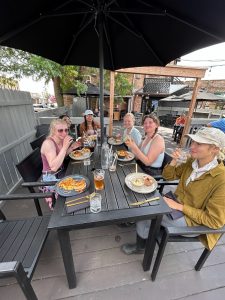 After that we headed out to have lunch at Duke’s Alehouse in Crystal Lake. An anonymous donor treated us to a very good meal, and we appreciate their generosity.
After that we headed out to have lunch at Duke’s Alehouse in Crystal Lake. An anonymous donor treated us to a very good meal, and we appreciate their generosity.
Then … more parsnip pulling. I’m sure that surprises nobody. Westwood’s parsnip is harder to find than other places, which usually have a wall of phototoxic plants lying in wait for us. Instead, the parsnips spread out, grow shorter and seed a little early. They look like stocky golden alexanders hiding in plain sight among all the prairie plants. But we found and destroyed them anyway. No parsnips are getting into the seed bank on our watch!
It was a great week, and I really enjoyed it. We got to do a variety of different things, and I picked up a couple of new skills. Next week looks like some very interesting things are coming up, but I’m not spoiling the surprise yet, of course!
